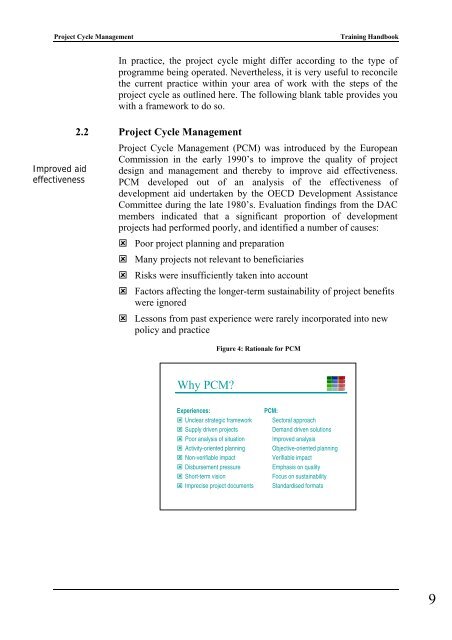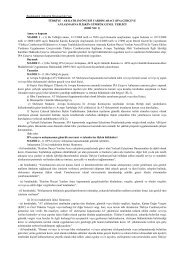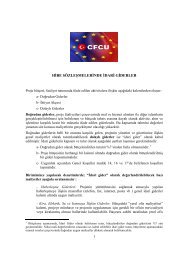Project Cycle Management Training Handbook - CFCU
Project Cycle Management Training Handbook - CFCU
Project Cycle Management Training Handbook - CFCU
You also want an ePaper? Increase the reach of your titles
YUMPU automatically turns print PDFs into web optimized ePapers that Google loves.
<strong>Project</strong> <strong>Cycle</strong> <strong>Management</strong> <strong>Training</strong> <strong>Handbook</strong><br />
Improved aid<br />
effectiveness<br />
In practice, the project cycle might differ according to the type of<br />
programme being operated. Nevertheless, it is very useful to reconcile<br />
the current practice within your area of work with the steps of the<br />
project cycle as outlined here. The following blank table provides you<br />
with a framework to do so.<br />
2.2 <strong>Project</strong> <strong>Cycle</strong> <strong>Management</strong><br />
<strong>Project</strong> <strong>Cycle</strong> <strong>Management</strong> (PCM) was introduced by the European<br />
Commission in the early 1990’s to improve the quality of project<br />
design and management and thereby to improve aid effectiveness.<br />
PCM developed out of an analysis of the effectiveness of<br />
development aid undertaken by the OECD Development Assistance<br />
Committee during the late 1980’s. Evaluation findings from the DAC<br />
members indicated that a significant proportion of development<br />
projects had performed poorly, and identified a number of causes:<br />
� Poor project planning and preparation<br />
� Many projects not relevant to beneficiaries<br />
� Risks were insufficiently taken into account<br />
� Factors affecting the longer-term sustainability of project benefits<br />
were ignored<br />
� Lessons from past experience were rarely incorporated into new<br />
policy and practice<br />
Why PCM?<br />
Experiences:<br />
� Unclear strategic framework<br />
� Supply driven projects<br />
� Poor analysis of situation<br />
� Activity-oriented planning<br />
� Non-verifiable impact<br />
� Disbursement pressure<br />
� Short-term vision<br />
� Imprecise project documents<br />
Figure 4: Rationale for PCM<br />
PCM:<br />
➾ Sectoral approach<br />
➾ Demand driven solutions<br />
➾ Improved analysis<br />
➾ Objective-oriented planning<br />
➾ Verifiable impact<br />
➾ Emphasis on quality<br />
➾ Focus on sustainability<br />
➾ Standardised formats<br />
9





